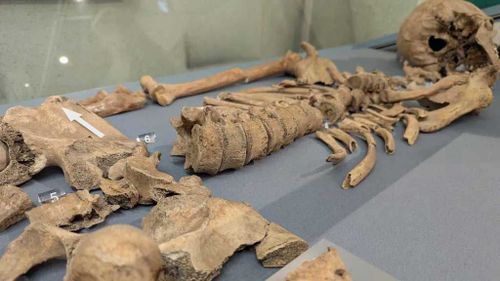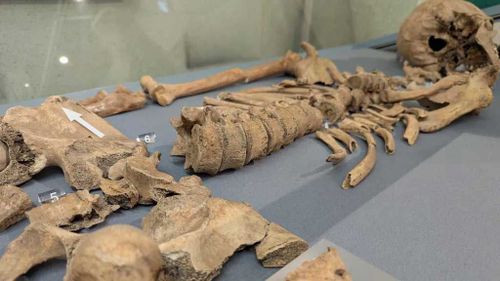Share this @internewscast.com
A skeleton unearthed from a fascinating Roman-era burial site in England might represent the first tangible proof of battles between gladiators and animals, as per recent studies.
The remains of a man, aged between 26 and 35 at the time of his death, displayed bite marks from a large feline — probably a lion — on his pelvis.

Gladiators were viewed as athletes at the time, and their owners wanted them to win so they would be able to fight again, the study authors said.
The lion bite never healed, which suggests it led to or caused his death, and the man was decapitated after death.
While this was a funeral rite for some in the Roman period, the researchers think the man was decapitated as a mercy killing after the lion bite.
“This is an incredibly thrilling discovery because it allows us to start forming a more detailed picture of these gladiators’ lives. It also verifies the presence of large cats and possibly other exotic animals in arenas in cities like York, illustrating how they too faced mortal danger,” Malin stated.
But how did a gladiator arena, and a lion, end up in northeast England?
An ancient epicentre of entertainment
Images of sparring gladiators, sometimes with one another or with beasts, memorialised in ancient mosaics and pottery recall the Roman Colosseum, “which would have been the classical world’s Wembley Stadium of combat,” David Jennings, CEO of York Archaeology and a doctoral researcher in the department of archaeology at University of York, said.
Jennings did not participate in the new research.
But such brutal sporting events had an extensive reach beyond the core Roman territories, and while an amphitheatre likely existed in Roman York, it hasn’t been discovered yet, Malin said.
The new findings indicate that Britain was well integrated into the customs and systems of the Roman Empire at its peak and provide evidence that Roman entertainments were widespread across the empire, said Jaclyn Neel, an associate professor of Greek and Roman studies at Carleton University in Ottawa. Neel was not involved in the research.
“The exact context for this encounter might have been a contest between a professional beast-fighter and the lion, which would have been exciting for the spectators, who might even have laid bets as to who would win,” Coleman said.
“Or it could have been a form of execution in which a criminal is exposed to wild animals, in which case presumably the spectators would enjoy the satisfaction of seeing justice being done, since a criminal would not elicit any pity.”

First pharaoh’s tomb found in Egypt since Tutankhamun’s
The lion was likely transported along well-established supply routes that also carried bulk supplies of wine, oil and grain across continental Europe and the Mediterranean to York given that it was a legionary base, said study coauthor Dr John Pearce, reader in archaeology and classics at King’s College London.
Big cats like lions would have been captured in northern Africa, then transported across the sea before being moved across a network of rivers and eventually the road from London to York.
“As tangible witnesses to spectacles in Britain’s Roman amphitheatres, the bitemarks help us appreciate these spaces as settings for brutal demonstrations of power. They make an important contribution to desanitising our Roman past,” Pearce said in a statement.
If the man who faced the lion was a professional hunter, as indicated in the study, the entertainment of watching human and a lion interact in the arena was probably more like bullfighting in Spain, Neel said.
“I do think it’s important to not exoticise the Romans — they were much more familiar with death than most modern North Americans, but that doesn’t mean that they tried to kill as many people as possible,” she said.
“Roman culture emphasised the control of man over nature. A beast hunt, to me, is a theatrical re-enactment of that control.
“Romans thus used the beast hunts to reinforce a sense of human superiority over nature, even for the spectators.”











